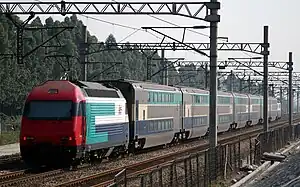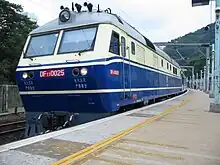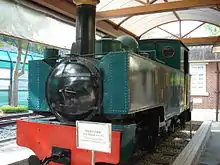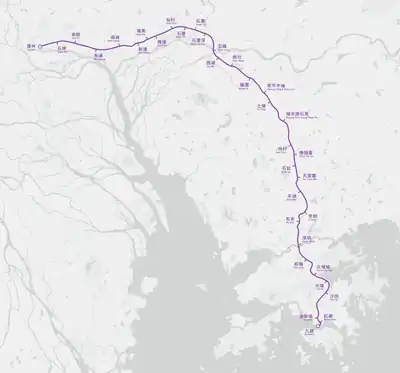Guangzhou–Kowloon through train
The Guangzhou–Kowloon through train (simplified Chinese: 广九直通车 or 港穗直通车; traditional Chinese: 廣九直通車 or 港穗直通車; pinyin: Guǎngjiǔ Zhítōngchē or Găngsuì Zhítōngchē) was an inter-city railway service between Hong Kong and Guangzhou jointly operated by the MTR Corporation of Hong Kong and the Guangzhou Railway Group of mainland China. Services operate along the East Rail line within Hong Kong territory, crossing the Hong Kong–Chinese border at Lo Wu, and continuing along the Guangmao Railway and Guangshen Railway in Guangdong province.
| Guangzhou–Kowloon through train 廣九直通車 | ||||||||||||||||||||||||||||||||||||||||||||||||||||||||
|---|---|---|---|---|---|---|---|---|---|---|---|---|---|---|---|---|---|---|---|---|---|---|---|---|---|---|---|---|---|---|---|---|---|---|---|---|---|---|---|---|---|---|---|---|---|---|---|---|---|---|---|---|---|---|---|---|
 | ||||||||||||||||||||||||||||||||||||||||||||||||||||||||
| Overview | ||||||||||||||||||||||||||||||||||||||||||||||||||||||||
| Service type | Inter-city rail | |||||||||||||||||||||||||||||||||||||||||||||||||||||||
| Locale | ||||||||||||||||||||||||||||||||||||||||||||||||||||||||
| First service | 5 October 1911 | |||||||||||||||||||||||||||||||||||||||||||||||||||||||
| Last service | January 2020 | |||||||||||||||||||||||||||||||||||||||||||||||||||||||
| Current operator(s) | ||||||||||||||||||||||||||||||||||||||||||||||||||||||||
| Route | ||||||||||||||||||||||||||||||||||||||||||||||||||||||||
| Termini | Hung Hom Foshan | |||||||||||||||||||||||||||||||||||||||||||||||||||||||
| Technical | ||||||||||||||||||||||||||||||||||||||||||||||||||||||||
| Track gauge | 1,435 mm (4 ft 8+1⁄2 in) | |||||||||||||||||||||||||||||||||||||||||||||||||||||||
| Electrification | 25 kV 50 Hz Overhead catenary | |||||||||||||||||||||||||||||||||||||||||||||||||||||||
| Track owner(s) |
| |||||||||||||||||||||||||||||||||||||||||||||||||||||||
| ||||||||||||||||||||||||||||||||||||||||||||||||||||||||

Twelve trains ran in each direction every day, with a journey time of 1 hour 40 minutes.[1]
The MTRC operates the KTT service on this route. The KTT service is provided by double-decker trains, usually comprising two Premium Class carriages and five First Class carriages. China Railway Guangzhou Group provides the other trains on this route.
Places served by the MTR Guangzhou–Kowloon Through Train include: Hong Kong, Dongguan, Guangzhou.
History
Early years

The original line of the Chinese section was called Kowloon-Canton Railway Corporation (KCR) and the British section was called Kowloon–Canton Railway (KCR), which later stretched a rapid transit network in the other New Territories regions in Hong Kong. The engineering partnership Messrs Arthur John Barry and John Wolfe-Barry were Consulting Engineers to the project.[2]
The segment within Hong Kong, then a British Crown colony, was known as the British section. Construction began in 1906, and it was opened on 1 October 1910 [3] as a single-track system, roughly corresponding to the present-day East Rail line).
The complete railway between Kowloon in Hong Kong and the Chinese city of Canton (Guangzhou) was opened on 5 October 1911.[4] With the Chinese section opened in 1911, through-trains ran from the southern terminus in Tsim Sha Tsui across the border to the southern Chinese city of Canton. Trains were steam-hauled. From the one-line railroad, the KCR network was expanded to three railway lines and a light railway system, with 32 railway stations and 68 light rail stations.
At first trains on the British Section ran northwards from a temporary terminus at Kowloon Point through the eastern New Territories up to the border with China at Lo Wu. The permanent southern terminus, Kowloon station in Tsim Sha Tsui, opened slightly later in 1914.
A narrow gauge railway operating works trains was used in the construction of the standard gauge British Section. The narrow gauge materials were later used to build the now-defunct Sha Tau Kok Railway.
Communist era
After the Chinese civil war and the victory of the Communists in mainland China in 1949, through-trains were no longer able to cross the border.
On 4 April 1979, the through train service between Canton (Guangzhou) and Kowloon (Hung Hom) resumed after agreement between Hong Kong and Chinese authorities. In January 1993, the service was extended to Foshan, and to Zhaoqing on 28 March 1995. Starting from 8 October 1995, some trains stopped at Changping station in Dongguan. In 1996, the northern terminus was relocated from Guangzhou railway station to Guangzhou East station.
Train service to Zhaoqing ended on 16 April 2017 due to renovation. Service to Foshan also stopped from 10 July 2019 following the opening of Guangzhou–Shenzhen–Hong Kong Express Rail Link. Both border crossings closed on 15 December 2021, ruling out any return of the through train service to the two cities.
The through train service was completely shut down on 28 January 2020 due to the outbreak of COVID-19 in Hong Kong.[5] Sources in April 2022 said the train service would not resume due to the Express Rail Link service extending to Guangzhou east station, therefore ending the century-long history of the through train service.[6]
Stations
Historic stations

The following shows the stations served by the through train in 1911 upon the commencement of service.[7] Most of them became stops of Guangzhou–Shenzhen railway. The through train service was suspended on 14 October 1949 after communists occupied Canton.
During this period, the through train service included new stops, such as in Tin Ho (天河), Wan Luk (雲麓), Sheung Shui (上水).
| Name | District | Opened in | Closed in | |
|---|---|---|---|---|
| English | Chinese | |||
| Canton also Tai Sha Tau | 廣九/大沙頭 | Canton, Kwangtung | 1911 | 1974 |
| Shek Pai | 石牌 | 1911 | – | |
| Che Pi | 車陂 | Punyu, Kwangtung | 1911 | – |
| Wu Chung | 烏涌 | 1911 | – | |
| Nam Kong | 南崗 | 1911 | 2009 | |
| Sun Tong | 新塘 | Tsengshing County, Kwangtung | 1911 | |
| Tong Mei | 塘美 | 1911 | 2007 | |
| Nga Yeo | 雅瑤 | 1911 | ? | |
| Sien Tsun | 仙村 | 1911 | – | |
| Shek Ha | 石廈 | 1911 | ? | |
| Shek Tan | 石灘 | 1911 | – | |
| Shek Lik Kou | 石瀝滘 | 1911 | – | |
| Shek Lung | 石龍 | Tungkun County, Kwangtung | 1911 | – |
| Sai Wu also Cha Shan | 西湖/茶山 | 1911 | – | |
| Nam Sheh | 南社 | 1911 | 2007 | |
| Wang Lik | 橫瀝 | 1911 | 2009 | |
| Sheung Ping & Muk Lun also Sheung Ping | 常平木倫 | 1911 | – | |
| Tu Tong | 土塘 | 1911 | – | |
| Cheung Muk Tou & Shek Ma also Cheung Muk Tou | 樟木頭石馬 | 1911 | – | |
| Lum Tsun | 林村 | 1911 | 2010 | |
| Tong Tou Ha | 塘頭廈 | 1911 | – | |
| Shek Ku | 石鼓 | 1911 | 2007 | |
| Tin Tong Wai | 天堂圍 | 1911 | 2007 | |
| Ping Wu | 平湖 | Sun On County, Kwangtung | 1911 | – |
| Li Long | 李朗 | 1911 | 2007 | |
| Pu Kut | 布吉 | 1911 | – | |
| Shum Chun also Sham Chun Market | 深圳/深圳墟 | 1911 | – | |
| ↑ Chinese section | British section ↓ | ||||
| Sheung Shui | 上水 | New Territories, Hong Kong | 1930 | - |
| Fanling | 粉嶺 | 1911 | – | |
| Tai Po Market | 大埔墟 | 1911 | 1983 | |
| Tai Po later Tai Po Kau | 大埔/大埔滘 | 1911 | 1983 | |
| Sha Tin also Shatin | 沙田 | 1911 | – | |
| Mong Kok | 油麻地 | Kowloon, Hong Kong | 1911 | – |
| Hung Hom | 紅磡 | 1911 | 1930/40s | |
| Kowloon | 九龍 | 1911 | 1975 | |
References
- MTR
- Minutes of the Hong Kong Legislative Council: 13 May 1909; 10 March 1910; 20 April 1911 www.legco.gov.hk.
- Hong Kong Government Gazette from 1910-10-07; https://sunzi.lib.hku.hk/hkgro/view/g1910/15197.pdf. Retrieved 2021-04-24
- The remaining section, i.e., the Chinese Section, corresponds to the present-day Guangzhou-Shenzhen Section of the Guangshen Railway Corporation (Simplified Chinese: 广深铁路).
- "高鐵城際直通車1.30起暫停 港鐵:乘客可獲全數退款 (22:46) - 20200128 - 港聞". 明報新聞網 - 即時新聞 instant news (in Traditional Chinese). Retrieved 31 May 2022.
- "港鐵停保養 城際直通車或永久停運 田北辰:高鐵料明年可抵廣州東站 屆時取消直通車". 明報新聞網 - 每日明報 daily news (in Traditional Chinese). 9 April 2022. Retrieved 31 May 2022.
- "Canton Kowloon Ry. Time Table". 3 October 1911. Retrieved 1 January 2020.